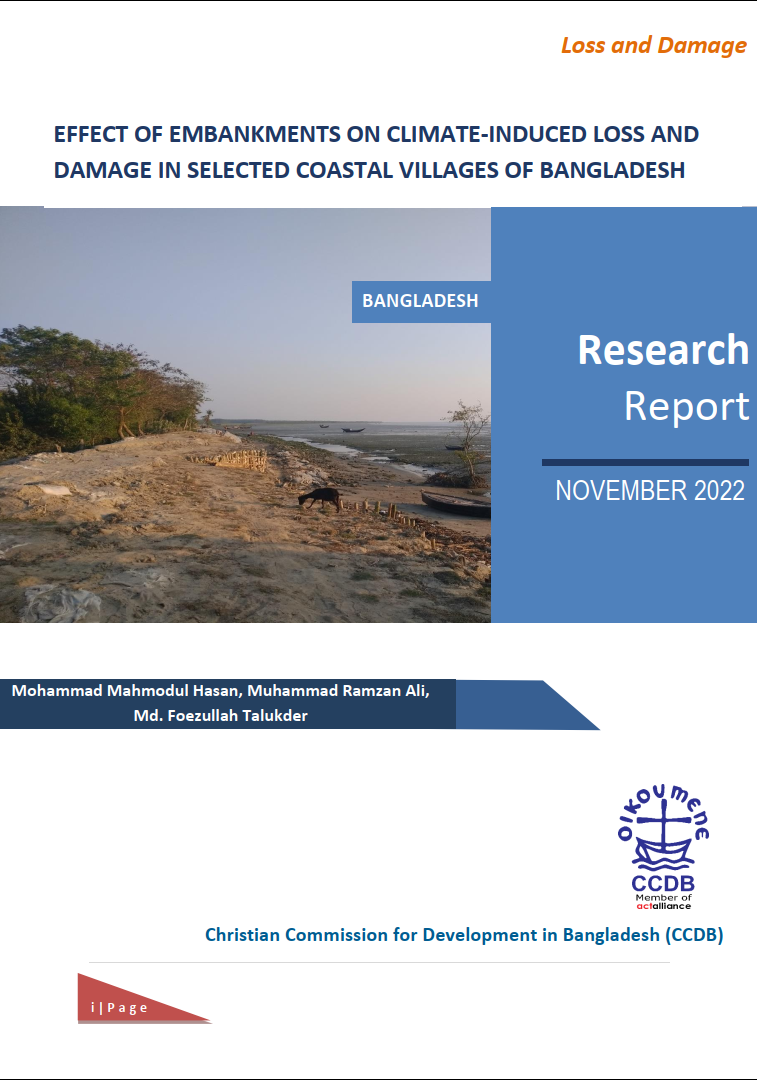LOSS AND DAMAGE: EFFECT OF EMBANKMENTS ON CLIMATE-INDUCED LOSS AND DAMAGE IN SELECTED COASTAL VILLAGES OF BANGLADESH

Bangladesh is globally recognized as one of the most high-risk countries for climate change due to its geographical position, topography, high density of population, poverty, and adaptive capacities against natural disasters. The southern part of the country is most vulnerable due to 47,201 km2 of coastal zone comprising 19 out of 64 districts of the country. The coastal zone is such a region where land, ocean, and atmosphere all interact with one another. The coastal zone is frequently affected by cyclones, storm surges, sea-level rise, and salinity intrusion, which all have caused terrible impacts on low-lying coastal areas and the people living in the region.
In this region, extreme weather and slow-onset events cause deterioration of the environment, loss of biodiversity, damage to infrastructure, changes land use patterns, and severe impacts on the livelihoods of the coastal people, up to the extreme that they are forced to displace. These effects occur due to insufficient and inadequate adaptation and disaster risk reduction, maladaptation, and inevitable impacts. If risk mitigation and adaptive measures cannot escape damages resulting from climate change, ultimately, they will result in loss and damage.
There are 139 polders in the coastal zone of Bangladesh. Polders are low-lying tracts of land surrounded by coastal embankments. These polders were built in the 1960s-1970s with a vision of protecting agricultural land from salinity intrusion and tidal floods. Out of the 2.8 million ha of cultivable lands in the coastal zone, almost half (1.2 million ha) are surrounded by polders (CGIAR, 2015). Over 8 million coastal people are dependent on these polders for their food security and livelihoods. A significant number of people live outside the embankment (river/sea side) and are more exposed to the sea. They are most vulnerable to climate change impacts compared to the people living inside the polders (countryside).
The study aimed to compare climate-induced economic and non-economic loss and damage within (countryside) the embankments and outside (river/sea side) of the embankments, explore the factors behind loss and damage differentials and find gaps in the policies for the coastal people as well as in the intervention by the government and non-government organizations. The study area was selected purposively where there had been the intervention of the Christian Commission for Development in Bangladesh (CCDB) for a considerable period, and samples were taken randomly from four villages of Shyamnagar Upazila of Satkhira District, Patharghata Upazila of Barguna District and Morrelganj Upazila of Bagerhat District. Both quantitative (questionnaire survey) and qualitative (focus group discussion, key informant interview) tools have been used to collect data and information required for the study. The questionnaire survey covered 465 households, 48 respondents from different professions joined the FGDs in four groups, and eight KIIs covered government officials, local leaders, and civil society.
There was a diversity of professions in the study area, but most were fishers. Around half (44.5%) of the respondents mentioned fishing as their main source of income. Almost one-third of the respondents lived in the khas land. The scarcity of drinking water was one of the biggest problems for the study area. In the rainy season, around two-thirds (64%) of the people had to depend on rainwater for drinking and cooking. They mainly depended on surface water sources like ponds for the rest of the year. Cyclones, tidal surges, and sea-level rise were responsible for salinity intrusion in the freshwater sources, which brought health hazards to the life of the coastal people. Climate-induced disaster impact was not the same for all classes of people living there, and the impact also differed inside and outside the selected polder embankment. People living outside the embankment were poorer than the people living inside. However, in terms of money, the people outside of the polder faced more loss and damage compared to the insiders, on average.
This study estimated that the aggregate monetary value of economic loss and damage resulting from both extreme weather events (four cyclones) and slow onset events (intrusion of salinity) encountered over the past 12 years came to BDT 136,287 thousand, including BDT 115,225 thousand (84.5%) caused by the extreme events and 21,061 thousand (15.5%) caused by the intrusion of salinity in the study area. Four major cyclones and salinity intrusions in the past 12 years caused an economic loss of BDT 300 thousand on average to the outsiders and BDT 285 thousand to the insiders as the average value of loss and damage per household came to BDT 293,000 as a whole, including BDT 248,000 (BDT 228,000 for inside and BDT 270,000 for outside locations ) caused by extreme weather events and BDT 45,000 (BDT 72,000 for inside and BDT 15,000 for outside locations) caused by slow-onset event over the period of past 12 years. Out of 245 households living outside of the embankments, 100 faced health impacts involving 141 persons, and 20 had had a death toll involving 26 victims in these cyclonic events. On the other hand, among 220 households living in the inside locations, 77 had been affected by health impacts covering 114 persons, and 16 families had had death cases involving 24 victims in the same cyclone events.
There is no significant difference in terms of support and services provided by the government for people living inside and outside of the embankments. Government agencies did not emphasize any cluster of the communities regarding the polder embankment. Both Government and Non-government organizations extended support to the affected people in the post-disaster times, and however, people found NGOs more supportive and accessible. Still, there is a lack of risk awareness regarding cyclonic events among the coastal people. Despite that, they were stout to face the thrust of cyclones. The coastal embankment saved the poldered people in many ways, but those who were outside of the polder had to undergo the impact of hazards on a bigger scale because of their direct exposure to various sudden onset events such as storm surges, cyclones, coastal floods, and high tide. Mismanagement of the polder was responsible for increasing salinity within the poldered land resulting in low yield of crops and scarcity of fresh drinking water.
Recommendations from the findings of the study are as follows –
- Development of a comprehensive mechanism to assess both economic and non-economic loss and damage at the local level
- Creation of diversified green employment opportunities
- Inclusion of a community-led approach in the planning of development works
- Establishment of good governance
- Resettlement of the people living outside the embankment
- Engagement of local community and youth in embankment management
- Construction of multipurpose community-led cyclone centers
- Publication date : 16th November, 2022
- Author(s): Mohammad Mahmodul Hasan, Muhammad Ramzan Ali, Md. Foezullah Talukder Download

